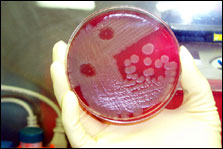Microbiological culture
Editor-In-Chief: C. Michael Gibson, M.S., M.D. [1]

A microbiological culture, or microbial culture, is a method of growing a microbial organism to determine what it is, its abundance in the sample being tested, or both. It is one of the primary diagnostic methods of microbiology. A tool is often used to determine the cause of infectious disease by letting the agent multiply (reproduce) in predetermined media in laboratory.
The most common method of microbiological culture uses Petri dishes with a layer of agar-based growth medium in them to grow bacterial cultures. This is generally done inside of an incubator. Another method is liquid culture, where the bacteria are grown suspended in a liquid nutrient medium. Bottles of liquid culture are often placed in shakers in order to introduce oxygen to the liquid and maintaining the uniformity of the culture.
The term culture can also, though infrequently and informally, be used as a synonym for tissue culture, which involves the growth of cells or tissues explanted from a multi-cellular organism.